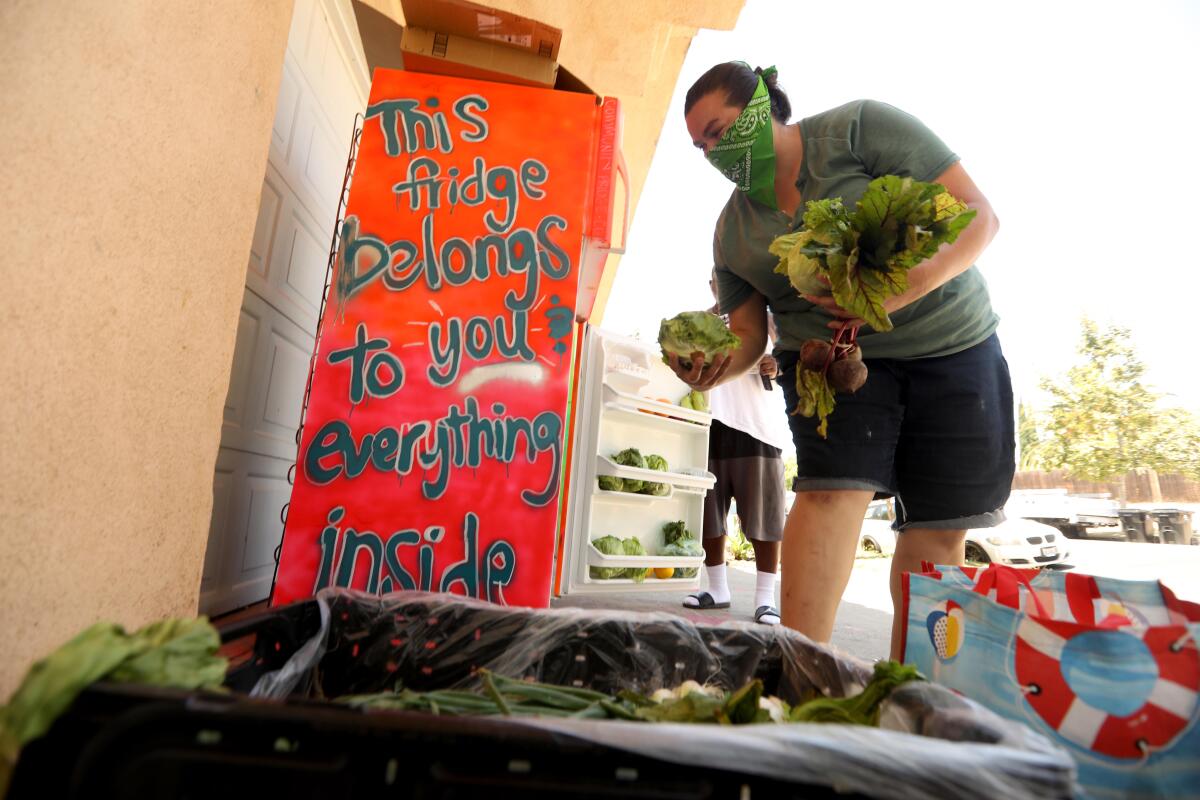Newsletter: How 2020 has transformed charitable giving

Good morning. I’m Rachel Schnalzer, the L.A. Times Business section’s audience engagement editor, back with our weekly newsletter. The pandemic has changed much about how we live, including how we give.
As shutdowns and layoffs have fueled great need, Americans have been generous. On the Tuesday after Thanksgiving alone, people in the U.S. donated nearly $2.5 billion — up 25% from the year before, according to the GivingTuesday movement.
It’s not just more money to all the same places. Reshaped priorities have lifted up some causes and left others behind. Organizations that have relied on in-person volunteers are feeling a pinch as people stay home to avoid the coronavirus.
An alternative to the traditional charity is flourishing: Mutual aid networks, which involve a focus on community organizing, have gained prominence.
I spoke with experts to learn more about how giving has evolved in 2020.
People are still giving
In previous economic crises, “we’ve seen charitable aid take a hit,” says Benjamin Soskis, a senior research associate at the Center on Nonprofits and Philanthropy at the Urban Institute. But during the pandemic, available data suggest, “people have actually increased their giving,” Soskis says.
Why are people continuing to give even during a difficult economic time? “Individuals always open their hearts and their checkbooks in a disaster,” says Jan Masaoka, chief executive of the California Assn. of Nonprofits. “And this is the biggest disaster.”
Where money is going
Hunger- and health-related charities have seen increased giving during the pandemic, experts say. “The food banks and the Meals on Wheels, the food pantries, have had their demand grow tenfold. And in many cases their donations have also soared,” Masaoka says.
However, it’s unclear how long giving to pandemic-related charities will continue. “Places in California, for example, where there have been wildfires, there clearly is giving fatigue,” Masaoka says. “Disaster giving just has never been and continues to be not a sustainable model.”
Tough time for arts organizations
Charities that rely on in-person programming are among the hardest hit during the pandemic. “That’s the theaters, the museums, the music centers,” Masaoka explains, in addition to after-school programs and senior centers. “They’re not able to have either their earned income, like ticket sales to their museum, or [in-person] fundraising events.”
Many charities are also low on in-person volunteers, Masaoka says. “Something we’re really concerned about is how many nonprofits have just lost the ability to attract the volunteers that they have in the past.”
Some organizations have found ways to pivot to virtual fundraising. My colleague Ronald D. White covered the innovative ways four charities have adapted during the pandemic.
Racial justice gains attention
2020 brought increased attention on racial justice issues, Soskis says. In the past, “there was a small subset of large-scale funders who were committed to racial justice,” he says. “Now, there’s a much larger group of both individual donors and institutional donors who don’t see it as a kind of fringe, niche interest, but see it as really key to the way they think about all issues.”
That hasn’t translated into much funding specifically earmarked for people of color, though. An August report from the Center for Disaster Philanthropy and Candid, a nonprofit that tracks philanthropy, found that “only 5% of funding by foundations and public charities to specified recipients was explicitly directed for persons and communities of color.”
Don’t get scammed
People still need to be aware of scams when considering a charitable gift. “It’s definitely an issue in all disasters, including this disaster, because disaster brings the crooks out,” Masaoka says. “These crooks create nonprofits with names that sound like they might be something similar to an organization you might have heard of.... Make A Wish and veterans organizations and food banks are just plagued with crooks creating copycat organizations.”
One way to minimize your chances of giving money to a scam: “Give to a nonprofit that you know,” Masaoka suggests. She recommends donating to nonprofits based in your community and to places you’ve volunteered in the past, as well as asking your friends and family if they know of a reputable organization in need.
Another way of avoiding charity scams: Donate your time and resources through mutual aid networks, Soskis says. “It brings a level of intimacy and connectedness.”
A different kind of giving
Mutual aid networks and other alternative means of giving have grown in prominence during the pandemic, Soskis says. “The disorientation that was introduced by the crisis, I think, shook up [our] reliance on institutions.”
Mutual aid networks are not charities. They tend to focus on organizing a community and promoting an ethos of cooperation rather than just providing money and items to individuals.
They often take the form of neighborhood groups made up of volunteers who meet one another’s needs, as well as neighbors’ needs. While traditional charities operate unidirectionally, with donors and recipients as distinct groups, “the spirit of mutual aid allows for participation, including from the people who are benefiting,” KTown For All organizer Michael Dickerson says. In other words, those who benefit from a mutual aid group are welcome, though not required, to join in and offer their own resources to others.
KTown For All, a volunteer-led grass-roots organization focused on people who are homeless in Koreatown, has experienced “a lot of interest driven by a pandemic, and then by the protests” against racial injustice that picked up momentum this spring, Dickerson says. “I think people want to get directly involved and don’t always know what’s happening to the money they donate when they’re donating to larger philanthropic organizations.”
Other grass-roots activity
In addition to mutual aid networks, “we have seen a big increase in person-to-person giving” that often takes place virtually over sites such as GoFundMe, Soskis says.
There are some concerns about this method of giving. “It’s a Band-Aid that only people that are internet-savvy [and] have relatively prosperous friends and relatives … have access to,” Masaoka says.
Soskis agrees that it can present equity issues. “There is evidence that people with the best networks, most compelling stories ... gain the most charitable resources.” This presents a tough dynamic, he says: Those who lack wealthier networks and the digital savvy to create a successful fundraising campaign are likely to be those who need the money the most.
In addition, Masaoka emphasizes that person-to-person giving should not have to be relied upon as a substitute for health insurance. “It’s just not a sustainable or equitable solution.”
Keep this in mind come tax season
In past years, taxpayers had to itemize in order to claim charitable deductions.
But this year, as part of the CARES Act, you can deduct up to $300 in cash contributions even if you do not itemize. “This makes it open to the 90% of taxpayers who don’t itemize,” Masaoka says. If you’re interested in making charitable deductions, take a look at this breakdown from the Internal Revenue Service.
Consider subscribing to the Los Angeles Times
Your support helps us deliver the news that matters most. Become a subscriber.
Other stories you may find helpful
◆ California’s new workplace safety rules for the COVID-19 era are now in effect. Jie Jenny Zou explained the policy shortly before it was finalized.
◆ U.S. employers added only 245,000 jobs last month — down from 610,000 in October. Don Lee reports on the latest sign that the economy may be stalling.
◆ Beware of “debt parking,” columnist David Lazarus advises. He explains how collectors may illegally plant fake debt in your credit file that can surface when you apply for a loan or a job.
◆ A controversial TSA program kept surveilling some travelers without reason, a government audit has found. Hugo Martín explains that the audit found no proof the Quiet Skies program makes travel any safer.
◆ Do your friends seem to have more money than you? Certified financial planner Liz Weston has some advice for getting over money envy.
◆ Canceling student debt should be a slam dunk, columnist Michael Hiltzik writes. He breaks down why “there should be nothing controversial about canceling student debt.”
One more thing
Should California ban gas in new homes?
Forty cities and counties — including San Francisco, Oakland and San Jose — have already prohibited or discouraged gas hookups in new construction over the last year and a half, according to a Sierra Club list.
Now the California Energy Commission is crafting its next update to building regulations, and climate activists are urging the agency to ban gas hookups in new construction statewide. Sammy Roth reports on the battle heating up over natural gas.
Have a question about work, business or finances during the COVID-19 pandemic, or tips for coping that you’d like to share? Send us an email at californiainc@latimes.com, and we may include it in a future newsletter.




